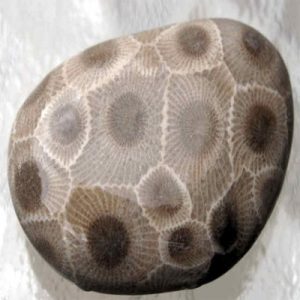Petoskey Stone
Petoskey Stone is a fossilized coral, named Hexagonaria Percarinata, from the Devonian Age, about 350 million years ago. Hexagonaria Percarinata is a genus of colonial rugose coral. Rugose is from the Latin word rugosus meaning wrinkles, referring to the wrinkled or “corrugated” walls between the individual coral organisms in the colony. These coral colonies consist of tightly packed, usually six-sided corallites, which are the skeletons of the once-living coral polyps. At the centre of each polyp was the mouth that contained tentacles that reached out for food. The hexagonal shape of each cell and thin lines radiating out from the dark mouth in the centre are distinguishing features unique to this fossil.
Petoskey stones are unique to the Traverse Group rock strata in the Gravel Point Formation. They are fragments of a coral reef that was deposited during the Devonian period. Petoskey Stones are found in Northern Michigan near the town of Petoskey on the southeast shore of the Little Traverse Bay of Lake Michigan at the mouth of the Bear River. The stones can be found on beaches and inland in the area. Petoskey Stones can be very attractive and interesting when polished into cabochons.
Petoskey Stones and the town of Petoskey are named after an Odawa (Ottawa) Indian chief, Chief Ignatius Petosegay (1787-1885). The name Petosegay is said to mean “rays of the rising sun” in the language of the Odawa Indians. It is said that if you study the fossil stone you will see the radiating pattern of the “rays of the rising sun” in each cell. Chief Petosegay’s father was a French Canadian fur trader and his mother was an Odawa Indian. In the summer of 1873, a city began on his land along Little Traverse Bay. The settlers named the new city Petoskey, an anglicized form of Petosegay, in honour of Chief Petosegay.
The town of Petoskey became a summertime destination for Victorian tourists and the unusual fossil specimens were popular souvenirs. The tourists began referring to the local Hexagonaria percarinata fossils as Petoskey Stones. This is probably because “I’m bringing you a Petoskey Stone” was much easier to fit on a postcard than, “I’m bringing you a Hexagonaria percarinata fossil.”
In June of 1965, the Petoskey Stone was named Michigan’s official State Stone and Miss Ella Jane Petoskey, the only living grandchild of Chief Petoskey, attended the formal signing. In the city that bears his name, a bronze statue of Chief Petosegay stands on a bluff overlooking Little Traverse Bay.


